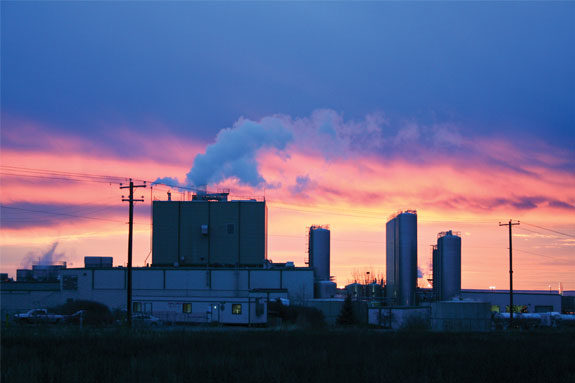If you are into numbers, the trends in demand and supply are a fascinating topic, especially when you apply the concept to the dairy industry. The theory is simple – an increase in demand allows prices to rise, encouraging supply growth. As stocks and supply increase to the point of excess, prices fall, resulting in a contraction of supply and reset of the supply/demand balance. The reality is a long way from simple and that has certainly proved to be the case in our research on the U.S. dairy market.
Charting milk production trends
The starting point for me is an understanding of the milk production trend. The comparison of milk production with the prior year can be very misleading if the prior year production was unusually high or low.
The seasonally adjusted data tells us that U.S. milk production climbed out of the doldrums during 2010 but quickly went into reverse in January and February 2011. You won’t see that analysis and conclusion in too many other places because year-on-year production growth has stayed up at about 2 percent.
In the context of a normal growth pattern, and corrected for seasonality, milk production has, however, fallen back below the long-term trend. This is primarily a reduction in milk production per cow.

To understand what triggered the fall, you need look at the situation from the farmer’s perspective. See Figure 1 .
Setting the price signal
For farmers, milk price is just one consideration when looking at the value created. In the U.S. market, the other primary driver of farm profitability is feed price – feed being the major cost input.
Typically, the impact of feed on dairy production is reported by way of the “milk-to-feed-price ratio.” This ratio gives an indication of the relative value of milk and feed cost, and we don’t like it.
Ratios tell you what direction things are moving (most of the time), but they tell you nothing about real profitability.

We like to use the mantra made famous in the film Jerry Maguire – those immortal words, “Show me the money!” See Figure 2 .
The black line at the top is the U.S. all-milk price. The pink area shows the cost of a typical feed mix (corn, soybeans, alfalfa). The milk price and feed cost used in this chart gives a milk-to-feed price ratio that is very close to the monthly figure routinely reported by the USDA.
The blue area at the bottom of the chart shows how much money is left over after feed costs – the margin available to pay for all other costs.
You can see that the famous volatility of the past 15 years is no less evident in this chart, but margin (or income) after feed cost is a purer indication of the economic pressure on farms. Other cost and income factors do fluctuate from year to year, but not as much as feed and milk price.

Finding the production/price driver
Figure 3 shows the dollar margin above feed costs, along with an indicator of milk production trend. The margin data is taken from Figure 2 above.
The more difficult concept to explain here is the seasonally adjusted milk production relative to the long-term trend. U.S. milk production has been growing at about 1 percent per year for more than 25 years. This chart shows the difference between the long-term trend line and our calculation of seasonally adjusted milk production.
(In engineering, we call the type of behavior illustrated in Figure 3 a “bang-bang” control system. Not much changes until you hit an upper or lower limit.)
You can see that there is some month-to-month noise in this chart, but generally speaking, milk production follows some reasonably stable trends.
Which brings us to an interesting question: What is the correlation between the two lines?
The answer is that you would be hard pressed to find a strict mathematical relationship between the margin over feed costs and milk production or milk production growth rate. What you do see, however, is that farmers respond to rapid and significant change, and they also respond to trigger points.
In engineering, we call this type of behavior a “bang-bang” control system. Not much changes until you hit an upper or lower limit. At the limits, the trends start moving in the other direction.
An even better analogy would be a game of ping pong between processors and farmers – the ball will always bounce back, but the point of impact, speed and amount of spin is quite unpredictable.
For the futurists who are trying to get in early and beat the system, here are a few observations about margins you might like to consider:
• The trigger point on the low side is about $6 to $7 per hundredweight (cwt). When margin dips down to this level, farmers will start to turn down production and keep it down – even if the margin trend is improving.
• The trigger point to start milk production growth is about $10 per cwt. A growth trend will commence when margins reach this level and track upwards until a reversal is triggered at the low margin end.
• There is a very interesting response to rapid changes in margin. A margin shift of $3 to $4 per cwt will trigger a corresponding farmer response (both up and down). Farmers appear to make a step change in their feeding regime within a month or two of the margin signal.
What is also interesting about these rapid events is that they are, more often than not, a short and sharp spike in margin. It is almost as if a rapid change is required to pull or push production to a new level and once there, the market eases back to a normal trend.
These shifts appear to be limited to an increase or decrease of about 2 percent in production and are generally associated with a change in milk production per cow. The step change is small relative to overall production.
It is likely that a group of farmers more sensitive to the market make a significant shift in feeding regime. This is diluted by a much larger group of farmers who do little or nothing.
The step change behavior in margin and milk production gives rise to the title of this article. Farmers appear to respond slowly to market signals and the market needs to make a lot of noise to get a significant and immediate change in direction.
The majority of these events appear to spike on the high side. Unless you create a significant incentive for growth, the supply side will continue to trundle along in roughly the same direction.
Where to from here?
We’d like to think we get a better view of the world, but we can’t see into the future. What we can do, however, is tell you whether the current market environment is consistent with past experience. We can also test whether the futures market is making similar assumptions.
Following the global financial crisis, there was a sharp production decline in 2008-2009. U.S. milk started to rebound when the margin over feed cost rose back to just under $10 per cwt. This was achieved by an increase in milk production per cow.
The rate of growth then slowed when production per cow approached the upper limit of genetic potential – farmers were prepared to increase feed but were less inclined to increase herd size.
We have recently seen a sharp correction downward in U.S. milk production in response to higher feed prices and lower margins. This supply collapse appears a little unusual in that the all-milk price margin after feed cost is still relatively high.
This is not the situation when you base the margin on the Class III milk price. In that case the margin over milk price fell to just $5 per cwt during December and January. Farmers responded immediately by turning down the feed dial.
The market has responded to the production drop by rapidly increasing the Class III milk price from $13.50 per cwt in January to a projected price of $19.50 in March – “Sorry, we made a mistake – don’t turn off milk production just at the moment.”
To be fair, in October and November it did look like there was too much milk and cheese in the system. International demand for butter and milk powder pulled more milk into Class IV milk, and Class III milk had to follow.
The futures market for Class III milk suggests a softening of milk prices during the year – from April the price is projected to drop from the current high of $19.44 per cwt to about $17 per cwt.
When the futures market for corn and soy is applied with an estimate on alfalfa price, the corresponding projection for margin after feed cost is in the range $6 to $7 per cwt. History suggests that is not enough to trigger an increase in milk production – production will not recover from the drop in January and February.
The Class IV milk futures are projected to stay firm in 2011 at $20 per cwt. International price markers suggest that may be a reasonable bet. The recent news out of China is that their demand will continue to grow, but production will lag – it will take a further two to three years for their local industry to recover and restructure after the melamine scandal.
At this milk price the margin opportunity is close to $10 per cwt – enough to kick-start production growth.
This is not the first time I have said the futures market doesn’t make any sense, and it probably won’t be the last. It looks to me like processors are trying to have 50 cents each way – they do want milk for powder and butter, but not for cheese.
It is a confusing signal and it seems unlikely that farmers will trust the export market and the reliability of the Class IV milk price.
My tip is that the ping pong ball is definitely back on the processors’ side of the table and farmers will be looking for a better milk price across the board to restart milk production growth. At the current feed prices, that means a milk price at $18 to $20 per cwt.
To processors and the rest of the market, this may seem high against the background of historical U.S. prices. They may need to swallow hard and put their hand in their pocket; the price target is there for a good reason. PD
Dr. Jon Hauser has more than 25 years’ experience in food and agriculture industries as a researcher, manager, CEO, consultant and company director. More recently he has established Xcheque.com, an online news, data and analysis service for the global dairy industry.
Xcheque provides a unique and independent perspective on the economics of the dairy supply chain from farm to market.
References omitted due to space but are available upon request to editor@progressivedairy.com .







